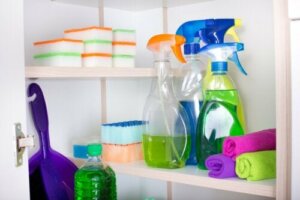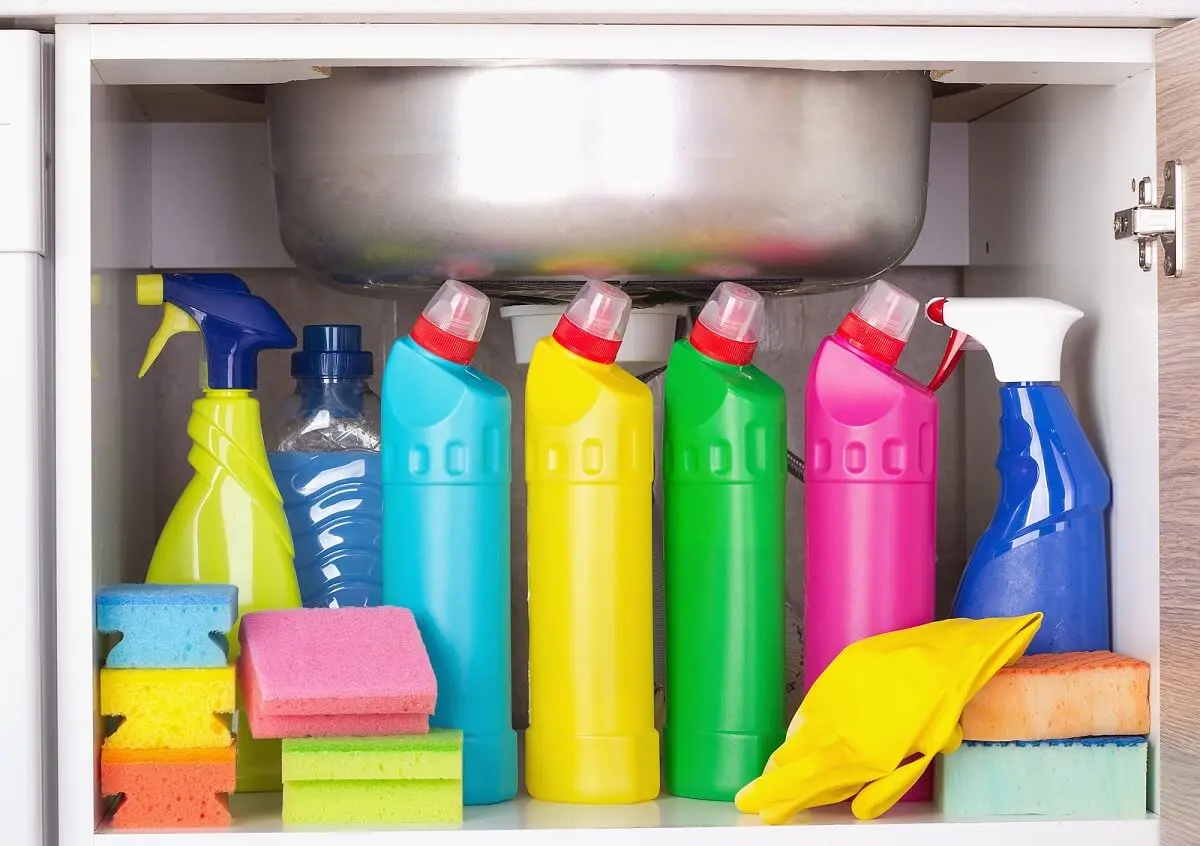How to Store Cleaning Products Safely

Storing cleaning products is an activity that many people ignore. However, it’s necessary to do it safely. This way, potential risks of poisoning or intoxication can be avoided for all the inhabitants of the house, including animals and plants.
It must be taken into account that most commercial cleaning products have toxic components. That’s why it’s important to handle them properly, even when they’re not being used.
Let’s take a closer look at some tips for proper storage.
Seven things to keep in mind for storing cleaning products
Optimal storage is important. You don’t want to put the safety of your loved ones at risk. Here’s everything you need to know about storing cleaning products properly.
1. Find a safe place
A hidden space is ideal. Cleaning products should be out of sight. This is not only because they don’t add anything to the aesthetics, but also because most of them come in brightly colored containers that are attractive to children. They’re even a hazard for pet owners.
What’s the solution?
Store chemicals in a closed, ventilated room. While this is impossible in many homes, you can opt for a cabinet with doors unless you have something custom-made.

We think you’d like to read: 8 Myths About Cleaning Bedding and Mattresses
2. Ventilate the place you store cleaning products
The area you’ve set aside to store your equipment and cleaning products may be the hallway, bathroom, kitchen, or perhaps the garage. This is fine, as long as you ventilate the area regularly.
All chemicals give off fumes that, if concentrated, can be toxic. Consider doing this at least once a week.
3. Keep an eye out for expiration dates
Any expired product can become dangerous, whether it’s ingested or not. It turns out that the components with which chemical products are manufactured can react amongst themselves and form a very harmful mixture.
Thus, it’s wise to periodically review the labels to get rid of the chemicals whose expiration date has passed.
4. Always use the original container
Don’t pour the contents of the products into other containers, especially if they’re also used for food. Believe it or not, this is a very common practice; many people find the original packaging unattractive. However, this could have serious consequences, such as poisoning.
It takes only a small oversight to overlook the fact that you’re ingesting an acidic substance instead of juice. On the other hand, it’s not enough to rinse out a chemical bottle and then use it to store other things.
Keep in mind that cleaning products come in concentrates, so they soak into the surfaces that contain them.
5. Get some cleaning organizers
Leave the clutter behind!
You don’t need a cleaning cart like they use in hotels, but you may want to get a smaller cleaning basket or organizer. This will allow you to have the products you frequently use at hand to move them in a group during household chores.
6. Keep order at all times
Organize and clean the area where you’ll store the cleaning products and utensils. In addition to keeping every corner of the house spotless, you’ll be able to keep track of the items you have. This way, you’ll have better control of what you need on your next trip to the supermarket.
7. Classify and sort by type of product
Having everything classified and ordered is a very practical measure when looking for a specific product. A widely used criterion is to organize by the function of the product. For example, keep glass cleaners, all-purpose cleaners, and sponges in a set, or boxes for specific purposes: one for the bathroom, another for the kitchen, and so on.
It’s best to use transparent plastic boxes that are deep and with a lid. Label them according to the criteria you chose. This way, you will find it better in the closet.

Some substances that you may find in cleaning products
Most of the chemical agents in cleaning products are effective and controlled substances to achieve a thorough cleaning. You should only use and store them according to the manufacturer’s instructions.
- Phosphates are used in many laundry detergents.
- Phthalates are a family of chemicals that you’ll find in the description of various household cleaning products.
- Chlorine bleach is undoubtedly the most familiar to everyone. It’s a key component in household bleaches.
- Sodium lauryl sulfate is another component in cleaning products. Its main function is to cause foaming.
You might like to read: 10 Things In Your Home You Aren’t Cleaning Enough
For less risk, opt for alternative cleaning products
Nowadays, alternative products are very present in homes looking more environmentally friendly. On the other hand, they’re often less expensive, without detriment to their effectiveness. Ingredients such as baking soda and white vinegar can be used as a base for elaborating these options.
Of course, during their use, you must apply a little more effort, in addition to an additional disinfection step. In any case, they’re safe, multi-purpose, and can make many tasks easier. Just be sure to handle them similarly to commercial products. Learn about mixtures to avoid here.
All cited sources were thoroughly reviewed by our team to ensure their quality, reliability, currency, and validity. The bibliography of this article was considered reliable and of academic or scientific accuracy.
- Wolkoff P, Schneider T, Kildesø J, Degerth R, Jaroszewski M, Schunk H. Risk in cleaning: chemical and physical exposure. Sci Total Environ. 1998 Apr 23;215(1-2):135-56. doi: 10.1016/s0048-9697(98)00110-7. PMID: 9599458.
- Gerster FM, Vernez D, Wild PP, Hopf NB. Hazardous substances in frequently used professional cleaning products. Int J Occup Environ Health. 2014;20(1):46-60. doi:10.1179/2049396713Y.0000000052
This text is provided for informational purposes only and does not replace consultation with a professional. If in doubt, consult your specialist.








